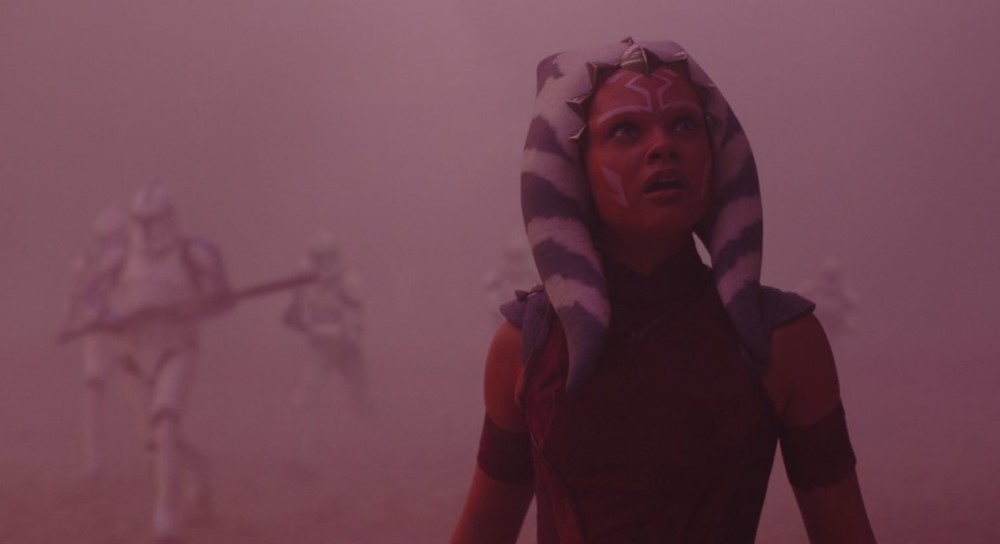Every time an episode of Ahsoka lands, Fantha Tracks will be giving their responses, and here are our initial gut feelings, deep dives and thoughts on the fifth episode, ‘Shadow Warrior’. Beware of spoilerific elements in here.
Eric Onkenhout
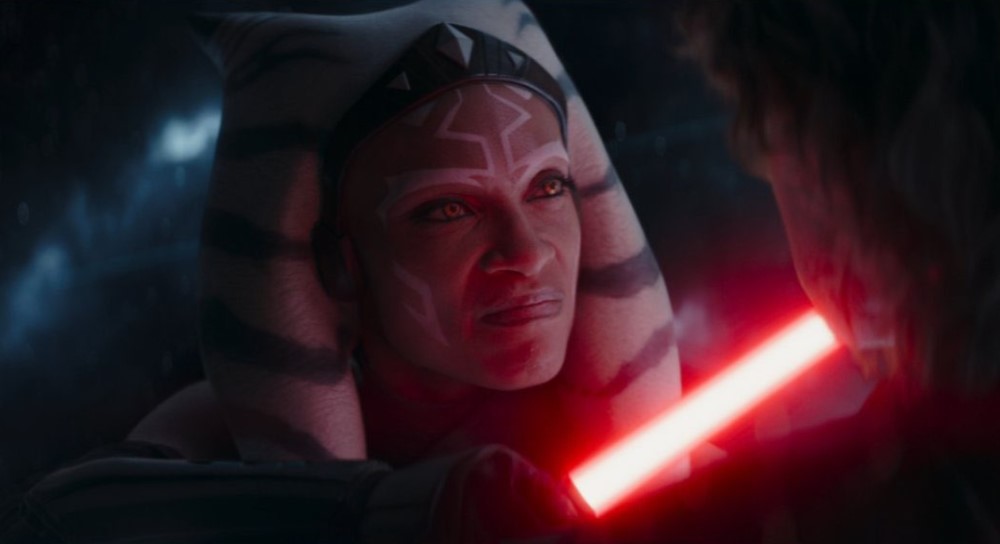 In episode 5 of Ahsoka, we’re on Seatos. Hera scopes out the area where Ahsoka was last seen while Carson searches from above. Jacen and Chopper also come out to look around. Hera sees Huyang holding Sabine’s helmet, but he is very somber. The circular rock formations looked similar to The Seeing Stone Grogu sat on in The Mandalorian.
In episode 5 of Ahsoka, we’re on Seatos. Hera scopes out the area where Ahsoka was last seen while Carson searches from above. Jacen and Chopper also come out to look around. Hera sees Huyang holding Sabine’s helmet, but he is very somber. The circular rock formations looked similar to The Seeing Stone Grogu sat on in The Mandalorian.
While close to death, Ahsoka sees a vision of her former Master, Anakin Skywalker, in the World Between Worlds. So far, since its first appearance, the World Between Worlds has shown influential people advising younger students: Ahsoka and Ezra, Ezra and Yoda, Ezra, and Palpatine, and now Ahsoka and Anakin, who is teaching Ahsoka to decide between life and death while showing her what she went through during the Clone Wars in flashbacks.
While Hera and Carson discuss whether or not they should report in, Jacen hears, possibly through the Force Ahsoka and Anakin’s lightsaber duel in the ocean waves. Hera hears it, but it’s likely a mind game for her.
As the duel intensifies, Anakin slices the platform underneath Ahsoka, sending her falling. She awakens in the middle of a battle where a Clone Wars version of Anakin Skywalker, played by Hayden Christensen, and a young Ahsoka, played by Ariana Greenblatt (Guardians of the Galaxy, Barbie), run towards the firefight. Ahsoka is disturbed by the carnage, but Anakin tells her the lesson: To survive, you must learn to fight.
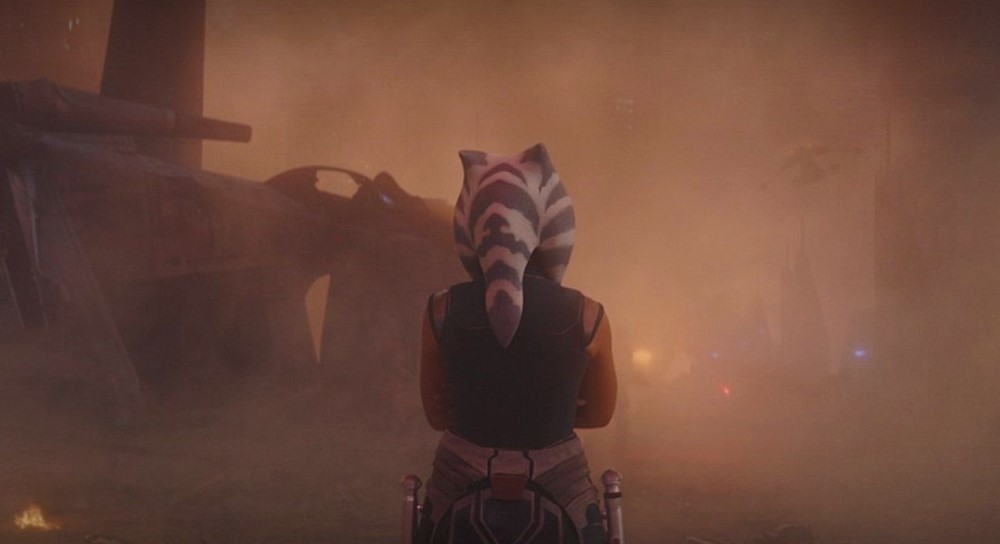 Ahsoka is not thrilled with the lesson, so Anakin takes a different approach. He now wears a Sith visage, holding a red lightsaber and yellow eyes. At this point, Anakin begins to blend into a vision of Vader, much like Palpatine changed into Sidious. The battle is furious. Ahsoka is able to outmaneuver Anakin and tosses his saber. “I choose to live,” Ahsoka says. Anakin’s vision changes back to a Jedi, and says, “There’s hope for you yet.” Then he disappears. Ahsoka is slowly submerged in water, which turns out to be the ocean where she fell when battling Skoll. She is rescued by the X-wing pilots.
Ahsoka is not thrilled with the lesson, so Anakin takes a different approach. He now wears a Sith visage, holding a red lightsaber and yellow eyes. At this point, Anakin begins to blend into a vision of Vader, much like Palpatine changed into Sidious. The battle is furious. Ahsoka is able to outmaneuver Anakin and tosses his saber. “I choose to live,” Ahsoka says. Anakin’s vision changes back to a Jedi, and says, “There’s hope for you yet.” Then he disappears. Ahsoka is slowly submerged in water, which turns out to be the ocean where she fell when battling Skoll. She is rescued by the X-wing pilots.
Ahsoka wakes up sometime later in a bunk on the Ghost with a white light shining on her. Jacen tells Ahsoka he heard her fighting, which Ahsoka finds very illuminating. Ahsoka also learns through the Force that Sabine is with Baylan and she is alive. Meanwhile, the Republic fleet is on its way to bring Hera and Carson back to Coruscant. Chancellor Mothma threatens to remove Hera’s rank.
Despite this, Ahsoka (in her white cloak), Hera, and Carson meet a group of Purgills, which is Ahsoka’s way of finding Sabine. Ahsoka brings her T-6 inside the largest Purgill just before the pod enters hyperspace. Destination unknown. When Sabine and Ahsoka separate, it holds the same uncertain feeling as the end of The Empire Strikes Back when Lando promises Leia they’ll find Han.
Final thoughts. De-aging Hayden looks excellent. I loved Leia’s mention by Carson Teva. I hope Jacen’s role grows and becomes a more prominent story member. Seeing live-action Anakin’s armor was so cool! And we see Ahsoka’s opinion of the Jedi’s role start to crack during the Clone Wars. Ahsoka walked away from Anakin in The Clone Wars, left Sabine, and believed Thrawn would return. She has been in darkness but is now more open to connections.
Brian Cameron
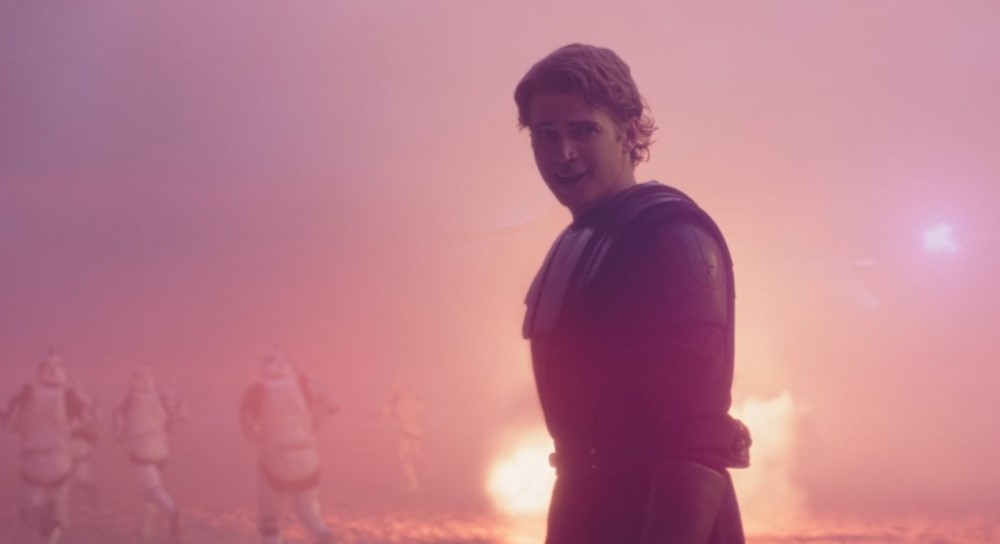 I don’t understand any of this episode to be honest.
I don’t understand any of this episode to be honest.
Why are they doing the Moby Dick story? Why do whales have hyperdrive engines in their butts? Why is David Attenborough not voicing over the animals? Why do Mandos have Maul horns? Why is the New Republic sending three massive ships after half a dozen star fighters?
It was so slow and underwhelming to me. Massive disappointment, as was looking forward to it. The plot has barely moved forward since the premiere, so I’ve kind of lost interest.
It all feels incredibly self-indulgent.
A tiny percentage of fans consume animation, in the same way a tiny percentage consume literature. You can’t produce content that only speaks to a minority of fandom, it has to be open to all.
Ross Hollebon
 Experiencing a Disney+ episode of Ahsoka in a theater is causing me to adjust my review approach. Thanks to the generosity and selflessness of Disney and Star Wars influencer and journalist Brooke McDonald, I was the final person admitted into a theatrical screening just outside Chicago. Experiencing Part 5 of Ahsoka on the big screen, with an amazing audio system and recliners that seemed to move slightly and rattle with the action, was worth the one-day, 7-hour round trip from Tuesday night into Wednesday morning.
Experiencing a Disney+ episode of Ahsoka in a theater is causing me to adjust my review approach. Thanks to the generosity and selflessness of Disney and Star Wars influencer and journalist Brooke McDonald, I was the final person admitted into a theatrical screening just outside Chicago. Experiencing Part 5 of Ahsoka on the big screen, with an amazing audio system and recliners that seemed to move slightly and rattle with the action, was worth the one-day, 7-hour round trip from Tuesday night into Wednesday morning.
For most of this review, I will focus on the flashbacks and reflections by Ahsoka in the World Between Worlds. I was joyfully surprised by the power of young Ahsoka confronting her past, her doubts, and her legacy as part of Anakin Skywalker’s Jedi lineage. By the end of the episode, in the belly of a Purrgil, she experienced Nirvana and a rebirth—an innocence and joy at just existing.
My experience at the theater plunged me into my own moment of enlightenment and remembering why I love Star Wars so much. Each story, arc, and episode within this property offers important lessons and themes that children can grow up with. It was magical nesting into a recliner for Part 5 and experiencing the history of Ahsoka from her young Padawan days and the beginning of a journey for Jacen Syndulla, with his strong Force abilities truly recognized.
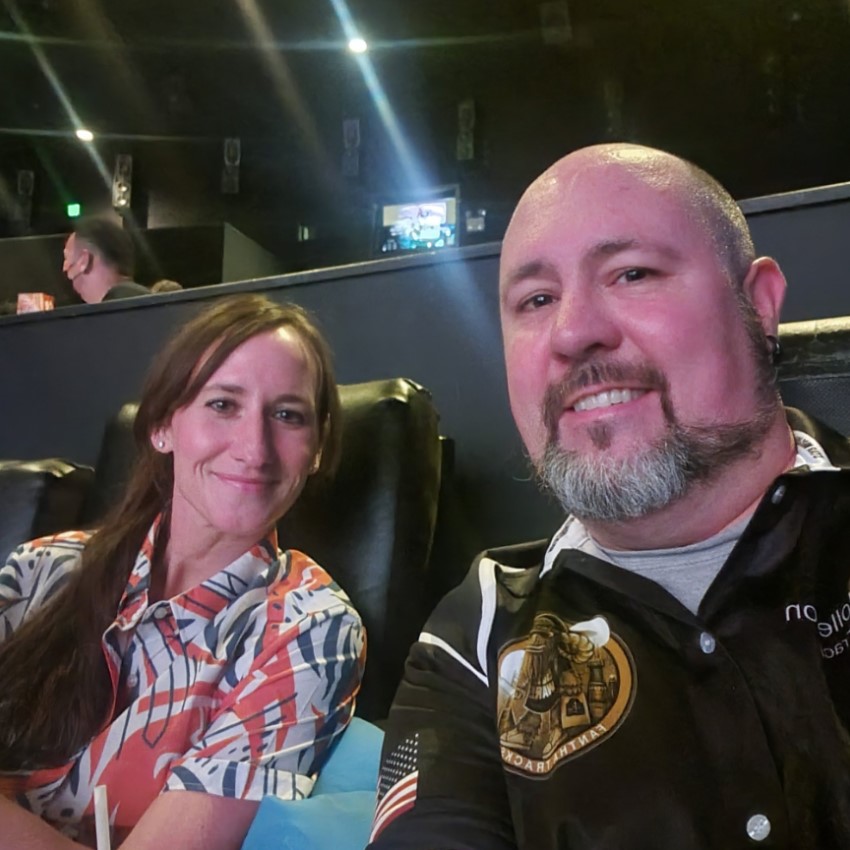 I smiled all episode long, and Brooke was emotional numerous times as we were treated to surprise after surprise. We cheered with the rest of the crowd and shared a congratulatory hug after the final credits disappeared. I felt like I was five and a half years old again, walking out of The Empire Strikes Back for the first time. It dawned on me that there were kids in this theater and their excitement was the most important energy that evening.
I smiled all episode long, and Brooke was emotional numerous times as we were treated to surprise after surprise. We cheered with the rest of the crowd and shared a congratulatory hug after the final credits disappeared. I felt like I was five and a half years old again, walking out of The Empire Strikes Back for the first time. It dawned on me that there were kids in this theater and their excitement was the most important energy that evening.
Brooke’s son, Auden, sat on his mother’s lap for the screening. When it ended she asked if he liked it and he responded with an elongated, celebratory, “Purrgil!!!” Giving him an immediate high-five was a highlight for me. Then, outside the theater, I met a member of the 501st Midwest Garrison. He was the first approved Clone Trooper Rex, so the scene on Ryloth was special to him. But more importantly, his daughter, wearing Ewok-style Mickey Mouse ears, was buzzing with excitement. It should be noted that her dad informed me she is the mini-Armorer cosplayer whom Emily Swallow famously posed with at Indy Pop Con in 2021.
The episode was as wonderful as the growing role of Jacen Syndulla and his Force powers. It was gut-wrenching interpreting the flash-flipping visuals of good Anakin, evil Anakin, and Darth Vader as viewed by Ahsoka. Part 5 was special because of the mystical elements, enchanting soundtrack, and the experiential opportunity offered to children (and adult kids) to soak it up on the big screen as part of a community.
Jen Sopchockchai Bankard
I have not, in some time, had as acute a response as I did by the end of this week’s episode of Ahsoka. When Hera says goodbye to Ahsoka as she rides in the belly of a purrgil, hoping to find Sabine and Ezra in an unknown galaxy, I felt deep emotion swell up. Hope in the face of loss. Hope in the face of failure. Destiny. The sense that all that has come before, good and bad, has led to this moment. The serenity, the sign of mental fortitude and readiness for the trials ahead. An openness. A childlike wonder at that which we do not yet understand. It was all there in that final moment, completely earned.
As a Padawan, Ahsoka had to become a child soldier during The Clone Wars. She quickly took on huge military responsibilities, commanding entire fleets and, inevitably, learning that her mistakes would cost hundreds of clones’ lives. Later, she learned that Anakin, her master, had fallen to the Dark Side and become Darth Vader. Both of these formative, devastating experiences have weighed her down. And, according to World Between Worlds Anakin, if she cannot move past her failures, fears, and guilt, she will not survive.
Ahsoka goes to the World Between Worlds because through that omni-temporal access point, she is able to relive her past in a way that allows her to reflect and illuminate her present. And yes, I choose to believe that’s where she really went. I don’t have an airtight argument as to why; I just think anything less undermines the meaning and impact of what we see. Nearly every line brilliantly serves as a signifier on two levels: for young Ahsoka fighting in the Clone Wars and for older Ahsoka fighting for her life in the World Between Worlds or the waters of Seatos (depending on your point of view).
There’s something distinct about walking through reanimated scenes from the past as if you were a passive observer of it. It’s perhaps the most recognizable feature of the classic holiday morality tale, but it’s important to note that in Ahsoka’s version, her older soul inhabits her younger body. She simultaneously re-experiences her past while also gaining the perspective she would from being a more passive observer.
Enter Dave Filoni’s philosophy on lightsaber fights. Filoni said that great lightsaber duels are not great because of the fight choreography, but because of the dramatic stakes. I feel as though the stakes here were very high — not only would we fight for Ahsoka’s life, but we would fight for her soul. More broadly, we would fight for the legacy of the Jedi, with which she has had such a complicated relationship. As fans, we would confront the legacy of Star Wars across trilogies. It seems Filoni’s primary goal in this episode is to get us to soulfully react to Ahsoka’s re-discovery of strength and hope. His secondary goal is to continue the lineage that George Lucas established, so that the significance of Qui-Gon Jinn’s death does not die with Darth Vader at the end of Return of the Jedi.
The lesson Anakin teaches Ahsoka is not literally to live or die, but rather to learn what it takes to choose to live. Through two powerful flashbacks, Ahsoka learns that choosing to live means accepting your mistakes. Even if they come at a great cost, these follies should not paralyze you, stopping you from trying to lead and do what’s right. Yes, the Jedi Order became corrupt and lost its way. They became political pawns in a war when they should have remained keepers of the peace. Yes, Anakin fell to the Dark Side. Yes, Ahsoka had a falling out with Sabine. According to Baylan Skoll last week, she cost Sabine her family on Mandalore. But that doesn’t mean Ahsoka should give up. In the context of Ahsoka’s final training, taking place in the current timeline, he’s encouraging her to cling to life and return to her friends because there’s still more for her to do. Failing them before is no excuse for not helping them now.
Ahsoka must be the light side’s leader in the upcoming battle against Thrawn and the other Imperial remnants, because it’s pretty clear that, despite Mon Mothma’s and Leia’s attempts to hack away at endless red tape, the New Republic will be of no help. Even though Ahsoka says she never wanted to be a soldier, Anakin says, “We must adjust to the times.” He’s referring to her life as a soldier Padawan, thrust into a war she didn’t start, but the same sentiment also applies to the current conflict of the Ahsoka series. No one wants to fight another war. The New Republic is flat out denying that there is anyone left to fight, plunging their heads into the sand, but Thrawn is coming and Ahsoka, Sabine, and Hera must “adjust to the times” because no one else will.
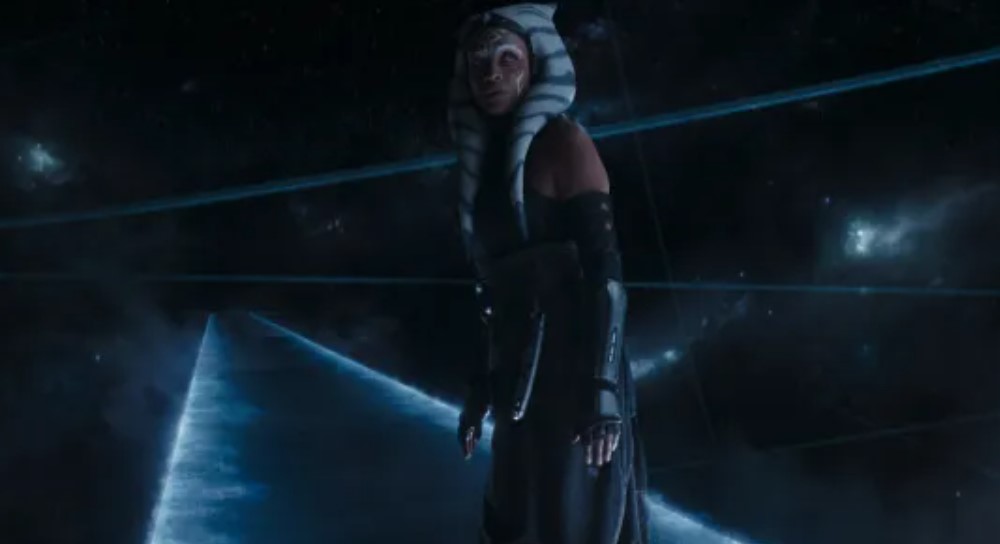 The entire screenplay for this episode is rich with double meanings, and this episode of Ahoska embodies that ideal, as every line uttered carries meaning for the past and the present simultaneously. That is why the best way for Ahsoka to learn and grow right now is to look back to lessons she learned in her youth. Ariana Greenblatt, by the way, inhabits young Ahsoka as if she’s been playing the character for years. She captured that signature cocktail of naive and sassy that Ashley Eckstein defined the character with in The Clone Wars. I was blown away by how seamlessly she and Rosario switched back and forth. They both nailed the playfully arrogant banter between Snips and Skyguy. That Greenblatt was able to hold her own and play off Hayden Christensen, who is quite possibly giving his career best performance here? Incredible.
The entire screenplay for this episode is rich with double meanings, and this episode of Ahoska embodies that ideal, as every line uttered carries meaning for the past and the present simultaneously. That is why the best way for Ahsoka to learn and grow right now is to look back to lessons she learned in her youth. Ariana Greenblatt, by the way, inhabits young Ahsoka as if she’s been playing the character for years. She captured that signature cocktail of naive and sassy that Ashley Eckstein defined the character with in The Clone Wars. I was blown away by how seamlessly she and Rosario switched back and forth. They both nailed the playfully arrogant banter between Snips and Skyguy. That Greenblatt was able to hold her own and play off Hayden Christensen, who is quite possibly giving his career best performance here? Incredible.
So, it’s the whole scene in which Hera says “May the Force be with you” to Ahsoka, in its entirety, and how it’s composed that makes me feel these complex things and NOT Hera herself feeling bittersweetly hopeful about parting ways with Ahsoka. It’s not just hope, though that’s a part of it. It’s more complex and intangible than that.
Visually, a huge part of what generates a Star Wars-specific affect is Ahsoka’s transformation from Ahsoka the Gray to Ahsoka the White. Her emerging from a near death experience and the World Between Worlds, while also being rescued by Jacen, Chopper, Hera, Carson, and the rest of their crew seems like the perfect time to transition the character’s look… even though I have already seen it in animation.
Back at the series premiere, I was confused by the nearly shot-by-shot recreation of the epilogue of Star Wars Rebels, in which Ahsoka appears in a white cloak and Sabine joins her after wistfully touching a painting of long lost Ezra. The most noticeable difference is that Rosario Dawson wears the same gray costume in the live action version. After that episode aired, the question of whether we would ever see live action Ahsoka in a white cloak was very open. Did this mean she had already undergone an illuminating experience, affording her the wisdom she seems to possess by the time we meet her again in The Mandalorian Season 2, or would her “Ahsoka the White” moment come at a later time? If so, how much later?
I realize now that I have been operating under the assumption that what I have seen in animation is fixed in the Star Wars timeline. Ahsoka going through her gray-to-white transformation here confirms that Filoni has adapted some events from Star Wars Rebels for the live action context rather than working around them. While I do feel slightly unmoored by this revelation about Star Wars animation as invulnerable canon, I don’t mind it at all. Live action has different demands than animation, and Filoni should make changes that make Ahsoka’s story more accessible to a wider audience. Costume changes aside, as long as this series keeps invoking that deep, soulful feeling, Filoni can veer from the animated canon as much as he needs. As Ahsoka herself says at the end of this episode, going anywhere, no matter how unpredictible, is better than going nowhere.
(This is condensed and edited – with permission – from Jen’s The Long Take review, which you can subscribe to here)
Dan Lo
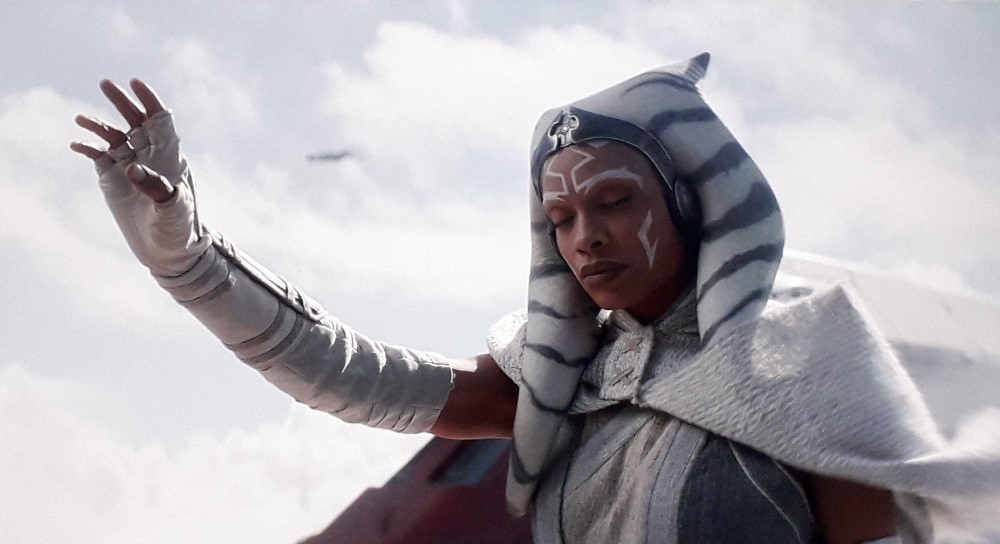 30 years ago, I was probably the biggest Star Wars fan in my circle of friends. I was barely aware that the internet existed, and the total number of Star Wars films was only three with no apparent hope for more. Today, none of the above statements are true. Well, my friends from that time still see me as a huge fanatic but when I set foot into any given Star Wars Celebration event, chances are I’m among the least knowledgeable fans on the premises. There are many reasons for this, but one in particular is my murky familiarity with The Clone Wars and Rebels. Both shows are ever increasing in relevance to live action Star Wars, and never more so than the latest episode of Ahsoka.
30 years ago, I was probably the biggest Star Wars fan in my circle of friends. I was barely aware that the internet existed, and the total number of Star Wars films was only three with no apparent hope for more. Today, none of the above statements are true. Well, my friends from that time still see me as a huge fanatic but when I set foot into any given Star Wars Celebration event, chances are I’m among the least knowledgeable fans on the premises. There are many reasons for this, but one in particular is my murky familiarity with The Clone Wars and Rebels. Both shows are ever increasing in relevance to live action Star Wars, and never more so than the latest episode of Ahsoka.
The first four episodes felt very much like Star Wars to me, and Part Five: Shadow Warrior takes a hard left. We are still in the Star Wars universe, but not a part of it that’s particularly recognizable to me. The scene in A New Hope where Han Solo dismissively denies the existence of the Force now feels profoundly far away. Despite having seen all of The Clone Wars and Rebels, mystical locations like Mortis and the World Between Worlds still feel really strange to me and continue to evade any sense of familiarity. After Ahsoka returns to the physical realm, I am plunged into yet another unfamiliar sight: This time filled with purrgil. While there is nothing mystical about them, I am still wrapping my head around the idea that an animal can have natural hyperdrive capabilities.
And yet, much of the episode is utterly recognizable, just in a very unexpected context. I admit I have no emotional attachment to The Clone Wars but it is still incredible to see live action Anakin from various phases of that era, both again and for the first time. Whatever de-aging technology was employed is done so to great effect with virtually no discernible uncanny valley this time around. Maybe it helps that Hayden Christensen still looks reasonably similar to his early 2000s self, but most impressive nonetheless. And of course, the aforementioned context is the stunning recreation of past clone wars era battles. Sure, the dream-like haze conceals a lot of detail but as far as my brain is concerned, those are real AT-TEs and LAAT-series gunships on screen. The sight of injured clone troopers being looked after by a 2-1B medical droid is also interesting, making for a relatively unusual type of scene in live action Star Wars. Very cool. Perhaps my only gripe is when young Ahsoka is fighting Mandalorians, and one of her kill strokes is a Samurai-esque slice to the neck. The choreography itself isn’t bad, but it seems to forget how lightsabers work. Also, are these Mandalorians not wearing beskar armor? I genuinely don’t remember.
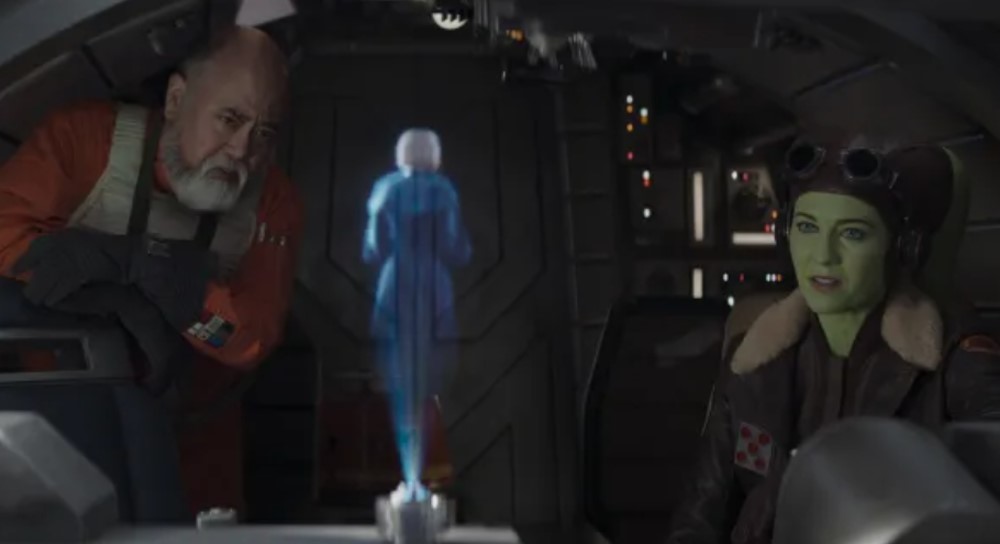 There is, of course, one version of “Anakin” that technically never existed: a red lightsaber-wielding, pre-Mustafar Darth Vader, somehow observing the Siege of Mandalore for the first time. Fully consumed by the dark side, the still-mostly human Vader attacks young Ahsoka Tano with a merciless ferocity. The young padawan is no match, with her trademark cross-saber defense collapsing under the force of the dark lord’s opening strike. She has never fought the most powerful version of Vader before, and it shows. The rest of the duel is almost difficult to watch, and shockingly ends with a kick in the stomach that sends Ahsoka flying. This may be the most vivid representation of a youngling-killing Vader we will ever get to see.
There is, of course, one version of “Anakin” that technically never existed: a red lightsaber-wielding, pre-Mustafar Darth Vader, somehow observing the Siege of Mandalore for the first time. Fully consumed by the dark side, the still-mostly human Vader attacks young Ahsoka Tano with a merciless ferocity. The young padawan is no match, with her trademark cross-saber defense collapsing under the force of the dark lord’s opening strike. She has never fought the most powerful version of Vader before, and it shows. The rest of the duel is almost difficult to watch, and shockingly ends with a kick in the stomach that sends Ahsoka flying. This may be the most vivid representation of a youngling-killing Vader we will ever get to see.
Then there is also the other lightsaber duel that takes place in the World Between Worlds, bookending the clone wars flashbacks. Very cool and surreal to see. Ahsoka ultimately triumphs, but spends most of the duel in defensive mode against Anakin’s apparently superior lightsaber skills. When she initially refuses to fight and Anakin remarks “I’ve heard that before“, is he referring to Luke on the second Death Star?
Full disclosure: I still have no idea if that’s the real Anakin in the World Between Worlds. He certainly seems to have Anakin’s actual memories, knowing full well where he has or hasn’t been. And unlike fake Vader in the Dagobah cave, this Anakin is still handy with a lightsaber. Or, maybe it doesn’t matter. Whether Anakin is real or exclusively in Ahsoka’s mind, his presence (to whatever capacity) seems to have served the purpose of helping her make it back to the other side.
Will we finally see Thrawn next time out?
Mark Newbold
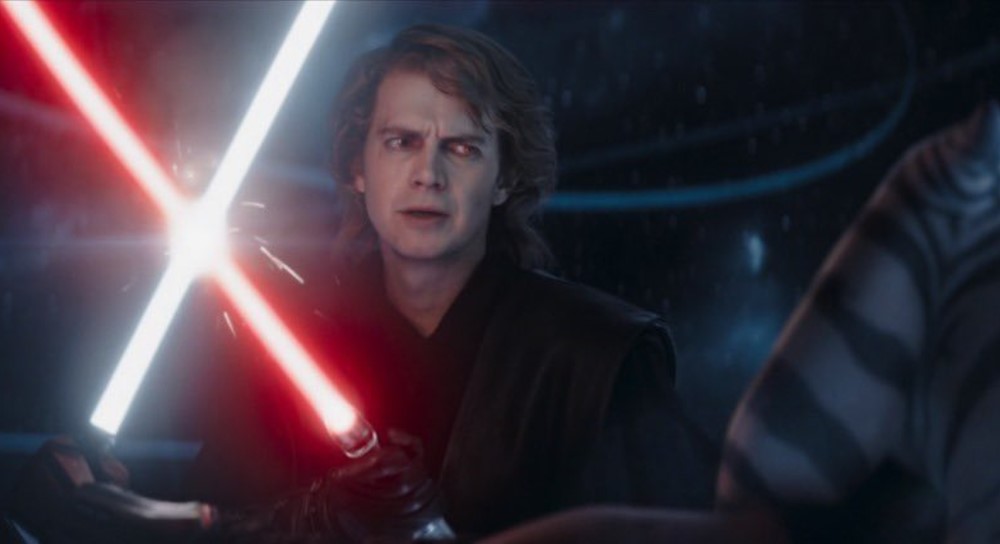 This past April at Celebration Europe at the ExCeL in London, Hayden Christensen became visibly emotional when thanking the fans for welcoming him back after his impactful but brief re-appearance as Anakin in Obi-Wan Kenobi. Now having seen what we saw in Part 5 Shadow Warrior, and conscious that he had almost certainly filmed that scene when he sat on the Star Wars LIVE stage, we can only imagine what was going through his mind knowing what was ahead for the fandom that he was becoming reaquainted with. Having seen it, we can fully understand why he got so choked up; this episode really was the return of Anakin Skywalker, and while the ‘reality’ of the episode is questionable, the effect it has on Ahsoka is tangible. For us as a viewing audience well aware of the rocky road Hayden travelled as Anakin during the prequel trilogy – a path regretably shared by Jake Lloyd and Ahmed Best amongst others – it’s a very real and heart-warming ‘redemption’, much like the one Best had as Kelleran Beq earlier this year in season three of The Mandalorian.
This past April at Celebration Europe at the ExCeL in London, Hayden Christensen became visibly emotional when thanking the fans for welcoming him back after his impactful but brief re-appearance as Anakin in Obi-Wan Kenobi. Now having seen what we saw in Part 5 Shadow Warrior, and conscious that he had almost certainly filmed that scene when he sat on the Star Wars LIVE stage, we can only imagine what was going through his mind knowing what was ahead for the fandom that he was becoming reaquainted with. Having seen it, we can fully understand why he got so choked up; this episode really was the return of Anakin Skywalker, and while the ‘reality’ of the episode is questionable, the effect it has on Ahsoka is tangible. For us as a viewing audience well aware of the rocky road Hayden travelled as Anakin during the prequel trilogy – a path regretably shared by Jake Lloyd and Ahmed Best amongst others – it’s a very real and heart-warming ‘redemption’, much like the one Best had as Kelleran Beq earlier this year in season three of The Mandalorian.
As ever, there’s a lot to unpack. The Ahsoka we’ve followed during the first half of the season has been guarded, closed off, a wannabe master who walked away from her apprentice Sabine. Now, delving into the mind of Ahsoka, perhaps we know why. Just as Obi-Wan was absolved of his guilt by Vader in the Kenobi series, so Ahsoka faces some harsh realities. She dances with the dark, flashes with the red-eyed lure of the dark side as Anakin realises she has the potential to be an even more powerful Sith than he was. It’s a brief Galadriel moment of knowing the power of the One Ring was beyond her control, and as she choses to live, Anakin steps back – the lesson is learned.
Her journey through the first half of the episode – and the Anakin scenes are just a part of the wider action – sees a younger Ahsoka (Ariana Greenblatt) dropped into the early days of the Clone Wars, where we see a Matt Lanter-era Anakin (and Hayden gives plenty of performance nods to his fellow Anakin actor) head into battle as Ahsoka tries to find her feet, culminating with a moment he wasn’t present for as the Siege of Mandalore roars, the ‘real’ Anakin far away on Mustafar ending Order 66 for his master. The action is fast and furious, brilliantly choreographed and clouded in the smoke of war that only adds to the atmosphere. We could have been presented with glorious vistas and grand sights; instead, the acrid smog of conflict obscures everything but the characters at the heart of the fight.
 It’s gripping stuff, played with conviction by Christensen as if 20 years hadn’t passed since he portrayed that version of the Chosen One in Revenge of the Sith. When he swings that blade like a brickbat, it looks like he means it, and here Rosario Dawson’s Ahsoka unfolds, like a veil has been lifted and the weight of the world dropped from her shoulders. As young Jacen helps his Mom Hera and the New Republic find her floating in the ocean, she wakes a new woman, now willing to trust in the Force and see where it takes them as they place their faith in the purgills and like Jonah and the Whale leap to a distant galaxy as Hera faces the music with her military superiors for disobeying orders.
It’s gripping stuff, played with conviction by Christensen as if 20 years hadn’t passed since he portrayed that version of the Chosen One in Revenge of the Sith. When he swings that blade like a brickbat, it looks like he means it, and here Rosario Dawson’s Ahsoka unfolds, like a veil has been lifted and the weight of the world dropped from her shoulders. As young Jacen helps his Mom Hera and the New Republic find her floating in the ocean, she wakes a new woman, now willing to trust in the Force and see where it takes them as they place their faith in the purgills and like Jonah and the Whale leap to a distant galaxy as Hera faces the music with her military superiors for disobeying orders.
Sure, like part three not much actually happens, BUT if you consider the shift of Ahsoka from the gray to the white a significant moment, then this may be the episode where you look back and go ‘that’s when it happened’. Intriguing, captivating, beautifully shot (props as always to Kevin Kiner for another stellar score) and performed (David Tennant as Huyang is fast becoming my favourite character in the show), this part of Ahsoka’s story was likely high in Dave Filoni’s thoughts when he envisioned the series. Skyguy and Snips have finally – kind of – been reunited, and Ahsoka Tano wil never be the same again.
Sander de Lange looks at all the reveals and easter eggs in Ahsoka – The Guide Part 5: Shadow Warrior.
Brian Cameron and Mark Newbold discuss Shadow Warrior on this weeks Good Morning Tatooine.
Mark Mulcaster and Mark Newbold discuss Part 5 on Making Tracks Reaction Chat: Ahsoka S1E5 – Shadow Warrior.


